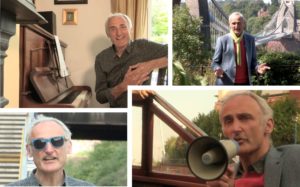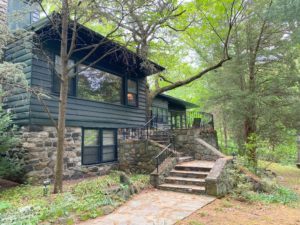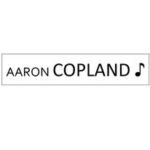
As New Year’s Resolutions go, my Aaron Copland Piece of the Day Tweets have been an out an out success! Hardly ever have I stuck so rigidly throughout the following year to an aspiration made in late December amidst one too many roast dinners. Looking back it was quite a challenge – to describe each piece from Copland’s oeuvre in 280 characters every day during 2020. And I have succeeded!
My initial reasons for embarking on this marathon, was to celebrate 30 years of being a fan, which also equates to 30 years since the composer’s death. The other aims were to bring more of the works to wider attention and also to pick out some of my favourite recordings.
I started on 1st January 2020 with Ceremonial Fanfare, a piece that I described as “a fanfare for our times – somewhat muted & introspective”. Little did I know that this was a perfect piece to start off a year like no other, a year when virtually everyone on the planet was affected in some way by the Coronavirus pandemic. Today, in my final Tweet the final Movement of Symphony No. 3 was chosen. This piece which includes a rescored version of Fanfare for the Common Man and Copland’s most jubilant and optimistic ending is also fitting as we close the page on 2020. As with the music, let us look forward hopefully to widespread vaccinations and normality being restored, but a normality that includes a greater respect for our planet.
I have become aware of new favourite bits in familiar pieces, certain works have gone up in my estimation and I have found a new set of artists with standout performances.
I must admit that back in January I felt daunted by the project. As I counted down the Tweets from 1/366 onwards it did look like a mountain to climb. However, I must say I am so glad that I did it. It’s been wonderful to afford myself the time to listen on a daily basis to music by my favourite composer. This has been a revelation as my level of focus has increased and I have become aware of new favourite bits in familiar pieces, certain works have gone up in my estimation and I have found a new set of artists with standout performances.
It is so easy as a casual listener to think that when you have a work on CD or LP that you don’t need to listen to another recording. Yet it is only when you listen to five or six performances next to each other that you realise the tremendous breadth in interpretation and recording sound. Nowhere was this more obvious for me than the Twelve Poems of Emily Dickinson (and the orchestral version Eight Poems). Copland asks a lot of questions of the soprano in this song cycle and I have chosen selections from many interpreters. There is an ever growing catalogue of recordings though and it would be wonderful to have a professional assessment of this masterwork and I would heartily recommend that BBC Radio 3 focus their Building a Library programme on this subject at some point in the future.
I’ve also been staggered by the differences in tempo. For me, as a listener who is still learning how to listen, this has been one of the easiest things to pick out. I’ve found some versions of short pieces to differ considerably in length. A bit like Goldilocks and the Three Bear’s porridge, there are certainly some pieces that are played too fast and some too slow and then ones that are just right. And on other occasions, the fast or slow versions really work too. I have enjoyed my growing confidence as a reviewer and getting an inner glow when I come across a recording that really takes my fancy.
For a couple of examples listen to:
- Four Piano Blues III Muted & Sensuous. The version by Leo Smit gets the balance just about right. By contrast and in my opinion, Michel Legrand’s works less well being so fast that a lot of the nuance & delicacy is lost. At the other end of the spectrum Iain Burnside accentuates the soporific.
- El Salon Mexico for orchestra. For me it’s hard to choose between the New Philharmonia Orchestra with Copland conducting and the Detroit Symphony Orchestra under Leonard Slatkin. Whereas the version by Antal Dorati and the Minneapolis Symphony Orchestra is such a sprint that’s it’s almost as though the conductor needed to catch the last bus home!
 Pieces that have gone up in my estimation include Copland’s High School opera The Second Hurricane. I think that my previous trouble with this work was that I heard it after The Tender Land and was hoping for more of the same. I remember feeling completely underwhelmed and therefore only returned to it once in a while mainly to listen to the sassy Sextet. Also, the slightly hackneyed dialogue put me off and left me a little embarrassed. However, my Twitter exercise meant that I listened to each movement in isolation and as a result started to hear some of the jokes, interesting orchestration and appreciating the choral settings. If you add into this mix the involvement of Orson Welles (Director) and Joseph Cotten (talking role as the airplane pilot) and all the New Deal optimism in the libretto (that would later be viewed as anti-American), it adds up to a fascinating work to explore. There is only one recording (Leonard Bernstein and the New York Philharmonic) but it would be great to hear some other interpretations.
Pieces that have gone up in my estimation include Copland’s High School opera The Second Hurricane. I think that my previous trouble with this work was that I heard it after The Tender Land and was hoping for more of the same. I remember feeling completely underwhelmed and therefore only returned to it once in a while mainly to listen to the sassy Sextet. Also, the slightly hackneyed dialogue put me off and left me a little embarrassed. However, my Twitter exercise meant that I listened to each movement in isolation and as a result started to hear some of the jokes, interesting orchestration and appreciating the choral settings. If you add into this mix the involvement of Orson Welles (Director) and Joseph Cotten (talking role as the airplane pilot) and all the New Deal optimism in the libretto (that would later be viewed as anti-American), it adds up to a fascinating work to explore. There is only one recording (Leonard Bernstein and the New York Philharmonic) but it would be great to hear some other interpretations.
In his final years Copland would probably have known nothing of anthropogenic carbon emissions and Climate Change. Yet 85 years on from the premiere of his opera, the impact of human activities on weather patterns and in particular North Atlantic hurricanes is obvious. I would love to see an updated version of The Second Hurricane with new dialogue that could explore this link further. As Copland was so committed for his music to be useful I think he would be intrigued by this possibility.
It’s been a blast and a great diversion allowing me to forget for a few moments the daily updates on Covid-19, Brexit and Trump!
One of the other big revelations to me has been finding out more about Copland’s film music. In virtually every case I listened to the music and then watched the particular cue with the music. I’ve long known that Copland was a master film composer but the pieces that were most enjoyable were the more incidental ones that I possibly didn’t even notice on the soundtrack CD. Watching the clips and seeing how well Copland’s music supports the film’s narrative and the unspoken thoughts of a character has opened a whole new dimension of appreciation for me. This part of my quest was helped enormously by two excellent new books on Copland’s film music which I was luckily enough to review:
- Unsettled Scores Politics, Hollywood, and The Film Music Of Aaron Copland and Hanns Eisler by Sally Bick
- Aaron Copland’s Hollywood Film Scores by Paula Musegades
Finally, as a result of this exercise I have found out more about many characters that Copland worked with during his life. This roll call of 20th century artistic life has been fascinating. In addition, for the first time I have actually read the poems that Copland set of Emily Dickinson, Ezra Pound, e e Cummings and others. Again, if I hadn’t embarked on this Twitter adventure I may not have been led down these absorbing avenues.
All in all, it’s been an honour and a privilege to delve so deeply into the life and works of Aaron Copland. It’s also been a great solace to immerse myself in the many types of soundscapes Copland drew for us – quiet city streets in the wee small hours, the hustle and bustle and traffic jams below towering skyscrapers, petrifying Vampire nightmares, Old West shoot outs, young love blossoming next to the soda fountain, loners in late night smoky speakeasy’s, fast paced railroad journeys, sweaty and exuberant Mexican salons and the sun setting on the lonesome prairie. It’s been a blast and a great diversion allowing me to forget for a few moments the daily updates on Covid-19, Brexit and Trump!









Leave a Comment